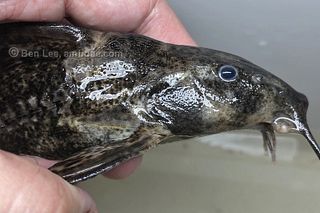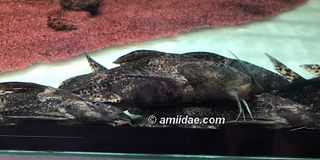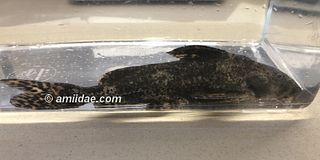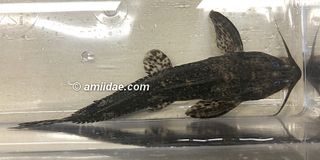Page 1 of 1
ID this Rhinodoras sp.
Posted: 27 Aug 2022, 10:17
by amiidae
Re: ID this Rhinodoras sp.
Posted: 27 Aug 2022, 17:21
by bekateen
As far as described species, only
is attributed to that region of Colombia (but not specifically in that waterway), with
slightly to the south and
to the north. Of course, museum collections are notorious for a few misidentifications, especially when an undescribed fish is collected and the collector might be just putting a name to it based on what's "supposed to be there."
Best, Eric
Re: ID this Rhinodoras sp.
Posted: 28 Aug 2022, 04:41
by amiidae
Thanks, Eric. That's my "fear" as well. Some species are harder to ID.
Any second opinion?
Re: ID this Rhinodoras sp.
Posted: 28 Aug 2022, 06:02
by bekateen
Sorry, I'm really not familiar with this group. But as I understand it, the species ID is based on the anatomy of the swim bladder, which is not really a trait you can check. There's a key to the genus here:
Re: Two new Rhinodoras
I agree, hopefully someone else has ideas about this.
Good luck,
Eric
Re: ID this Rhinodoras sp.
Posted: 28 Aug 2022, 10:32
by amiidae
Thanks again, Eric. I know some species are hard/impossible to ID based on photos.
As a hobbyist, it is always fun and exciting to pick up an "unknown" species.
Re: ID this Rhinodoras sp.
Posted: 28 Aug 2022, 13:53
by Jools
Could we see that pic of the head closer, please? I'm trying to make out the postcleithral process.
Cheers,
Jools
Re: ID this Rhinodoras sp.
Posted: 28 Aug 2022, 15:24
by bekateen
Jools wrote: ↑28 Aug 2022, 13:53
Could we see that pic of the head closer, please? I'm trying to make out the postcleithral process.
Cheers,
Jools
I too was trying to see the postcleithral process (PcP) clearly, but wasn't sure I could see its borders properly. The blue dot outline I drew over Amiidae's photo does align with the shape of the PcP in
and in
, but also
.
If my red marks are correct, the PcP depth/length ratio is 25%-26%; that value is consistent only with
R. gallagheri and
R. thomersoni, excluding the more southerly
R. boehlkei (PcP depth 37.5–53.6% of length)
Additionally, the snout length/head length ratio in this photo is 39%, which would include
R. thomersoni (SnL:HL range, 38.6–42.4%). According to Sabaj et al. (2008), the SnL:HL ratio range for
R. gallagheri is 44.8–49.8%, so if the photo permits a reasonable measurement, then this fish is not
R. gallagheri.
If this a described species, and if I am going just on morphometrics estimated from Amiidae's photo, I'd conclude this fish is .
Conversely, if your fish is not described, maybe we should create a new CLOG entry - Rhinodoras sp. `Manacacias`?
Cheers, Eric
Re: ID this Rhinodoras sp.
Posted: 29 Aug 2022, 12:46
by amiidae
Crappy shot but I hope well to see the feature.

Re: ID this Rhinodoras sp.
Posted: 29 Aug 2022, 16:45
by Viktor Jarikov
Cool detective work. Way out of my league but fun to watch and learn how it can be done. Thank you all so very very much!
Re: ID this Rhinodoras sp.
Posted: 29 Aug 2022, 19:04
by Jools
Great work Eric, I have to say the higher body height (BD) made me think about
hence my first post. It's just the distribution that makes one doubt if it is that species - there are not many fishes described from the Maracaibo basin that are also in the Meta.
The new species entry is probably the right course of action?
Jools
Re: ID this Rhinodoras sp.
Posted: 29 Aug 2022, 20:33
by bekateen
Jools wrote: ↑29 Aug 2022, 19:04
Great work Eric, I have to say the higher body height (BD) made me think about
hence my first post. It's just the distribution that makes one doubt if it is that species - there are not many fishes described from the Maracaibo basin that are also in the Meta.
The new species entry is probably the right course of action?
Jools
Thanks Jools. Okay, I'll create a new CLOG entry:
.
That said, using the new photograph, all of a sudden the measurements are not so helpful. This is the limitation of using photos for morphometrics when the photos are not taken in a controlled fashion of angle, distance, lighting, etc.
This time, the SnL/HL ratio I obtained is 43%, which is right between the normal range of R. thomersoni and R. gallagheri.
@amiidae, can I have your permission to upload these photos to the new CLOG page? Also, some of the photos (your initial pics) are too small to use. If you have larger images, could you please email them to me or share them here and I'll take them that way? And one last question - how confident are you that this fish was collected in the Rio Manacacias? What is the source of this info? Thanks.
Cheers, Eric
Re: ID this Rhinodoras sp.
Posted: 30 Aug 2022, 13:16
by amiidae
Thanks for all the inputs.
Eric, the origin came fm the source. so I say pretty reliable.
Let me try to get better images this wkend.
Re: ID this Rhinodoras sp.
Posted: 31 Aug 2022, 13:41
by amiidae
Re: ID this Rhinodoras sp.
Posted: 31 Aug 2022, 15:16
by bekateen
Thank you. The pics are uploaded.
Cheers, Eric
Re: ID this Rhinodoras sp.
Posted: 01 Sep 2022, 01:53
by bekateen
@Amiidae, do you have only one specimen of this fish? Or are your photos of more than one fish?
I retried the snout length/head length ratio on the latest photo and again got a value (48%) consistent with Rhinodoras gallagheri. I appreciate that it's difficult to get a fish to pose just right for meaningful measurements, but even so, usually I don't experience so much variation as I have between the first photo (39%) and the second and third photos (43% and 48%). Of course slight differences in camera angle are an issue, but I think more problematic is the fish altering its mouth shape, extending or folding under its mouth.
All that is to say that since the three photos provide results that are utterly inconsistent, I'm not so sure this fish doesn't have a more typical gallagheri shape... or is it two fish? But yeah, the coloration seems so much darker. I'm comfortable with it being its own clog entry.
Thanks again for the photos.
Cheers, Eric
Re: ID this Rhinodoras sp.
Posted: 01 Sep 2022, 13:07
by amiidae
there were abt 30pc in the LFS but I got only 1 pc.
Tell me what sort of angle or requirement. I will try to get the image.
I can shoot with a 100mm lens on a full-frame body. so I get 1:1 ratio
Re: ID this Rhinodoras sp.
Posted: 02 Sep 2022, 02:24
by bekateen
amiidae wrote: ↑01 Sep 2022, 13:07there were abt 30pc in the LFS but I got only 1 pc.
Okay, so all your previous photos are of a single fish - that means the different proportions I'm obtaining are due to slight variations in the angle of photography and due to variations in how the fish is positioning its mouth.
amiidae wrote: ↑01 Sep 2022, 13:07Tell me what sort of angle or requirement. I will try to get the image.
I can shoot with a 100mm lens on a full-frame body. so I get 1:1 ratio
Thank you @amiidae. The ideal photo is a perfect side shot, with the fish's barbels tucked under rather than extended forward. If your photo angle is from a slightly dorsal or ventral view, or slightly from the front or from the back, then it skews the 2-dimensional image of the proportions of the head.
If you can get one or more photos like that (showing from the tip of the snout to behind the operculum), that would be great. But if the fish is reclusive or just not cooperative, don't worry about it.

Cheers, Eric












